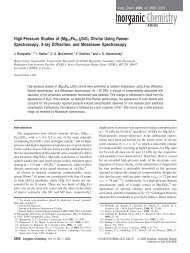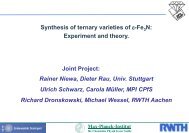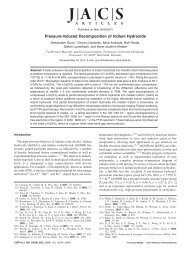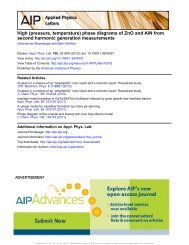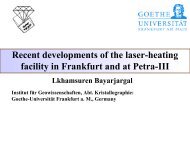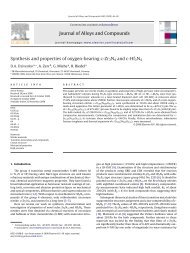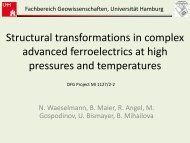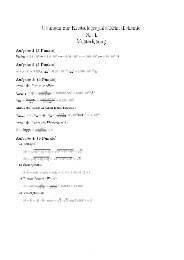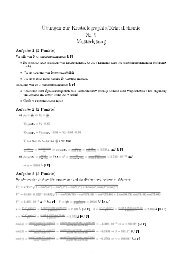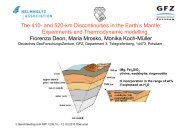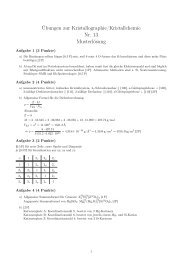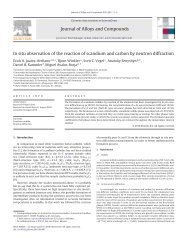Raman spectroscopic study of PbCO3 at high pressures and ...
Raman spectroscopic study of PbCO3 at high pressures and ...
Raman spectroscopic study of PbCO3 at high pressures and ...
You also want an ePaper? Increase the reach of your titles
YUMPU automatically turns print PDFs into web optimized ePapers that Google loves.
Phys Chem Minerals<br />
agreement with Lin <strong>and</strong> Liu (1997b). These modes can be<br />
divided into four main regions as shown in Table 1.<br />
Isothermal (293 K) compression<br />
<strong>Raman</strong> spectra <strong>of</strong> the out-<strong>of</strong>-plane (v2), in-plane (v4) <strong>and</strong><br />
symmetric stretching (v1) b<strong>and</strong>s <strong>of</strong> lead carbon<strong>at</strong>e on<br />
compression are shown in Fig. 1. The onset <strong>of</strong> two new<br />
peaks v2 0 <strong>and</strong> v1 0 (see Fig. 1) is observed <strong>at</strong> <strong>pressures</strong> <strong>of</strong><br />
about 8.9(2) <strong>and</strong> 10.2(2) GPa, respectively. The positions<br />
<strong>of</strong> the <strong>Raman</strong> b<strong>and</strong>s corresponding to the internal modes as<br />
a function <strong>of</strong> pressure up to 15.4(2) GPa, are shown in<br />
Fig. 2. Three cell loadings <strong>and</strong> experimental runs were<br />
Table 1 Assignment <strong>of</strong> <strong>Raman</strong> b<strong>and</strong>s <strong>of</strong> PbCO 3 <strong>at</strong> ambient conditions based on the space group Pnma<br />
done in order to check the reproducibility <strong>of</strong> the experiments<br />
<strong>and</strong> to verify the behavior <strong>of</strong> the v2 mode. In<br />
Fig. 2a–d results <strong>of</strong> the three experiments are presented in<br />
different colors to show the frequency vari<strong>at</strong>ions <strong>of</strong> b<strong>and</strong>s<br />
<strong>at</strong> different <strong>pressures</strong> <strong>and</strong> different runs. Results <strong>of</strong> all runs<br />
are in a good agreement <strong>and</strong> v2 shows, indeed, a mode<br />
s<strong>of</strong>tening. The first run was carried out up to 9 GPa, the<br />
second up to 14 GPa <strong>and</strong> the third up to 15.6 GPa. The<br />
results <strong>of</strong> the linear fit to the d<strong>at</strong>a from the third experiment<br />
will be discussed further below. The position <strong>of</strong> the v1<br />
b<strong>and</strong> increases linearly with increasing pressure (Fig. 2a)<br />
up to 15.4 GPa with a r<strong>at</strong>e <strong>of</strong> 2.53(4) cm -1 /GPa. The v2 out<br />
<strong>of</strong>-plane bending mode shows a mode s<strong>of</strong>tening (Fig. 2b).<br />
Region (cm -1 ) Wavenumber (cm -1 ) Assignment (Frech <strong>and</strong> Wang 1980)<br />
100–230 External modes 114.6, 130.2, 148.3, 173 <strong>and</strong> 218.5 Modes are associ<strong>at</strong>ed with transl<strong>at</strong>ions <strong>of</strong> the Pb 2? ions <strong>and</strong><br />
CO3 2- groups along different axis <strong>and</strong> with rot<strong>at</strong>ion <strong>of</strong><br />
2-<br />
CO3 groups<br />
600–900 Internal modes 671.2<br />
2-<br />
(1) B3g (v4-in-plane b<strong>and</strong> <strong>of</strong> CO3 groups)<br />
675.8<br />
2-<br />
(2) A1g (v4-in-plane b<strong>and</strong> <strong>of</strong> CO3 groups)<br />
683.8<br />
2-<br />
(3) B2g (v4-in-plane b<strong>and</strong> <strong>of</strong> CO3 groups)<br />
696.6<br />
2-<br />
(4) B1g (v4-in-plane b<strong>and</strong> <strong>of</strong> CO3 groups)<br />
839.2<br />
2-<br />
(5) A1g (v2-out-<strong>of</strong>-plane b<strong>and</strong> <strong>of</strong> CO3 groups)<br />
900–1,100 1,054.5<br />
2-<br />
(6) A1g (v1-symmetric C–O stretching <strong>of</strong> CO3 groups)<br />
1,200–1,600 1,371.3<br />
1,421.3<br />
1,478.1<br />
2-<br />
A1g (v3-asymmetric C–O stretching <strong>of</strong> CO3 groups)<br />
Fig. 1 <strong>Raman</strong> spectra <strong>of</strong><br />
PbCO 3 out-<strong>of</strong>-plane (v 2) <strong>and</strong><br />
in-plane (v 4) bending <strong>of</strong> CO 3 2groups<br />
as a function <strong>of</strong> pressure<br />
<strong>at</strong> room temper<strong>at</strong>ure: 1 B 3g<br />
(v 4-in-plane b<strong>and</strong>), 2 A 1g (v 4-inplane<br />
b<strong>and</strong>), 3 B 2g (v 4-in-plane<br />
b<strong>and</strong>), 4 B 1g (v 4-in-plane b<strong>and</strong>).<br />
The insets <strong>high</strong>light the v 2 0 b<strong>and</strong><br />
between 8.9 <strong>and</strong> 15.4 GPa <strong>and</strong><br />
the v 1 symmetric stretching<br />
vibr<strong>at</strong>ions as function <strong>of</strong><br />
pressure. An arrow denotes the<br />
signal <strong>of</strong> the diamond around<br />
740 cm -1 , which disappears<br />
with pressure. Spectra are<br />
vertically <strong>of</strong>fset for clarity<br />
v 1<br />
v 1 '<br />
v 4<br />
v 1<br />
v 2<br />
v 2 '<br />
123



